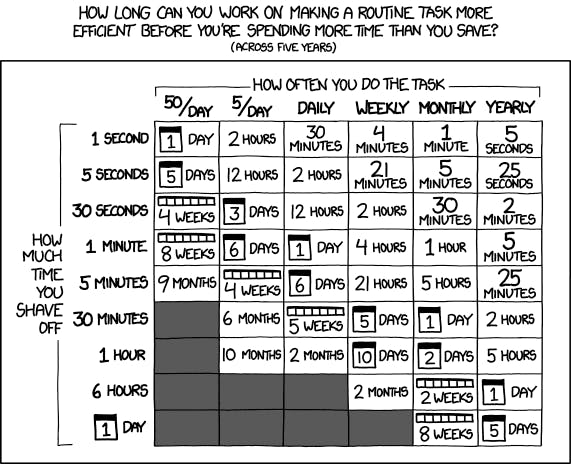Automation: The Secret Weapon in Field Service
January 13, 2020Field Service Software
Have you ever felt like you’ve spent a full-day working, without achieving anything meaningful?
Maybe you were jumping between different tasks and fixing mistakes that seem to happen all the time (and will happen again if you don’t keep your guard up.)
If you run a field service business, mistakes can be a costly thing; not only in terms of money but also when it comes to your credibility and your customers’ trust towards you.
At Emvisage, we help field service businesses with highly complex workflows to automate and streamline their processes.
What we’ve learned from having worked with dozens of field service professionals over the years is, that you can beat stagnation and prevent being overwhelmed with the right tools. One of these tools is automation.
In this article, we dig deeper into automation and we’ll explain why it will help you to:
- Reduce errors
- Reduce multitasking and context-switching
- Improve productivity by making tasks faster to complete or by eliminating them completely
- Understand your business better by breaking it down into components
- Transition into high-level thinking
Table of contents
- The ultimate goal for any business
- The 5 benefits of automation that will help you save time & money again and again
- When do you need to automate tasks?
- When should you NOT automate a task?
- Automation is not a magic bullet
- Examples of automation in Emvisage Field Service Software
Your goal is to deliver value to your customers
Fundamentally, the aim of any business is to deliver value in any form. Automation is one way for businesses to improve the process of delivering value.
Are you reactive or proactive?
Before we jump directly into automation, it is important to remember what behaviour and principles any company should aspire to in order to fully get the benefits of automation.
Let’s have a look at the difference between reactive and proactive leadership:

Looking at the table above, one question arises: What are the benefits of running your business in a reactive manner? None.
However, becoming proactive is difficult in the short term, but the transition is necessary in order to operate a successful business. But how does this reactive/proactive behaviour relate to automation?
Automation is proactive in its nature. Automation is about handling problems and tasks before they happen. It is one of the most powerful tools for proactive field businesses. Good automation can quickly elevate your business to the next level.
The 5 benefits of automation that will help you save time & money again and again
1. Significant reduction of errors
Humans are error prone. - Captain Obvious
Jokes aside, there is no need to delve much into this.
Machines never get tired and are extremely consistent as long they are correctly programmed. What employee operates on this kind of level? Nobody!
Rework is mostly created by human errors and it costs time, it is distracting, and can potentially affect moral as a lot of rework gives the impression of being stuck in an unproductive loop.
2. Less multitasking and context switching
Multitasking is extremely costly, and very hard to avoid, especially with new technologies and open workspaces.
Interruptions are becoming increasingly omnipresent: emails, smartphones, browser notifications, co-workers and even your watch are triggering context switching. Context switching requires brain-power and reduces productivity as most of the time is wasted when switching between tasks.
“Although switch costs may be relatively small, sometimes just a few tenths of a second per switch, they can add up to large amounts when people switch repeatedly back and forth between tasks. Thus, multitasking may seem efficient on the surface but may actually take more time in the end and involve more error. Meyer has said that even brief mental blocks created by shifting between tasks can cost as much as 40 percent of someone’s productive time.” Source: APA
If you automate repetitive and annoying tasks, there’s less need for context-switching and you can focus on the work that matters most to you and your team.
3. Higher productivity by making tasks faster to complete or eliminating them completely
As said, context switching is expensive, in terms of energy and time. Eliminating simple tasks can be tremendously beneficial, even though the task may take a few seconds to accomplish.
If you can’t fully automate a task, it is still useful to speed up the task’s completion; especially if it occurs frequently or takes a lot of time. We’ll delve into task frequency, duration, and other details later in this article.
4. A better understanding of your business by breaking it down into components
Have you ever thought you understood a mathematical concept, only to realise that you only get the basics of the concept, but you are still unable to apply the concept in order to complete questions?
Automation will force you to understand every component.
You can’t automate a task without clarity. Getting the necessary clarity will often uncover previously hidden steps and prompt new questions.
5. Transition to higher-level thinking
Automating your business’ processes will help you to get a new perspective. Ray Dalio describes his business as a “machine”. Looking into a machine helps you achieve higher-level thinking:
“Higher-level thinking isn’t something that’s done by higher-level beings. It’s simply seeing things from the top down. Think of it as looking at a photo of yourself and the world around you from outer space. From that vantage, you can see the relationships between the continents, countries, and seas. Then you can get more granular, by zooming into a closer-up view of your country, your city, your neighborhood, and finally your immediate environment. Having that macro perspective gives you much more insight than you’d get if you simply looked around your house through your own eyes.” - Excerpt From: Dalio, Ray. "Principles"
This concept of working on your business instead of working in your business is explained in many different forms throughout the business literature. As business owners, we understand how hard it is to dissociate ourselves from day to day operations in order to achieve higher-level thinking.
However, we believe that successful businesses are the fruits of higher-level thinking coupled with great execution. And automation, of course!
When do you need to automate tasks?

Source: https://xkcd.com/1205/
- The task is frequent
- It can be automated easily
- It is dull or “painful”
- Its maintenance is low
- Its impact is high
There are different factors to consider when automating a task. From our point of view, the tasks with the most “friction” are prioritised. Friction can be explained, in frequency, length, difficulty, error-prone, dullness of a task.
When should you not automate a task
- The maintenance would take as much time as doing the task itself
- The task is frequently changing
- The task requires higher intelligence, such as precise image recognition or fully understanding texts
In our experience, if you can’t automate a task because the nature of the task is always changing or the maintenance is too high, it means one thing: you shouldn’t!
For higher intelligence tasks, AI is progressing and is able to perform very well on specific tasks. But for overall intelligence and abstract reasoning, AI is still far behind. The good news is that many of those tasks can be performed offshore with the right processes and tools in place.
Why automation is not a magic bullet
While we believe a good level of automation is a must for business, we are also aware of the risks and challenges of automation.
Different skill set required
Depending on the complexity of the task to automate, other skills such as software programming might be required. Hiring an independent programmer is possible, but keep in mind that any external contractor coming from a different industry might not understand your business and its context well.
You should focus on what needs to be done, while the contracted programmer should focus on how it is going to be done.
Higher upfront costs
It involves getting a clear understanding of what needs to be automated. The communication effort can be increased when working with software contractors as new contractors might not have enough context to fully understand what needs to be automated. This is why very precise and clear communication is required.
Maintenance costs
Some automation might need maintenance. Maintenance is often overlooked. An example of automation maintenance could be to upgrade the way to push invoices after your invoicing software updates its product or adds new features.
Unhandled exceptions
“Out of sight, out of mind” is a terrible idea when it comes to automation. An automation task failing without being detected early can create more rework. The later the discovery, or the higher the frequency of this task, the more rework will be involved.
Examples of automation in Emvisage Field Service Software
- Auto-generating and sending of customer emails (e.g. when planning an installation, emails are filled and sent automatically)
- Sending of critical reminders to your back-office staff and your technicians
- Auto-generating and sending of documentation to clients and other parties by email
- Automatic creation of invoices in Xero (e.g.Invoices are pushed to Xero once installation is complete. All fields are filled using already existing information in the system.
Are you already on your automation journey?
No matter what work you do, at a high level you are simply setting goals and building machines to help you achieve them. - Excerpt From: Dalio, Ray. "Principles."
If you’re looking for a software to help you automate dull or time-consuming tasks in your field service business, let us help you with that!
We help field service business with highly complex workflows to automate and streamline their processes. Just drop us a message at info@emvisage.com. Let’s automate your workflows together!
